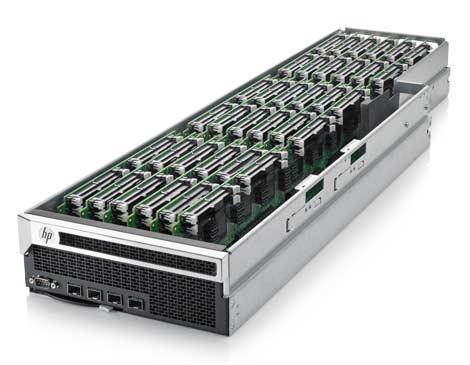
An HP Redstone Development Platform server, using ARM chip technology from Calxeda.
In the increasingly competitive battle to sell servers for "hyper-scale" data centers running armadas of servers, HP has turned to next-generation chip company Calxeda to power a new line of servers. Today HP announced the Redstone Development Platform, a line of servers running on many-core processors from Calxeda based on low-power ARM technology popularized in cell phones.
The Calxeda-powered servers are part of a broader HP initiative to develop low-power, many-core servers known as Project Moonshot. HP executives describe it as a multi-year, multi-phase effort to advance HP technology for hyper-scale computing. The name, a reference to the U.S. space program, suggests the ambitiousness of HP's thinking. Naming the platform Redstone - which was the launch vehicle for the first sub-orbital space flights during Project Mercury - reflects the fact that this is a starting point on a longer mission.
First Step: Testing and Proof-of-Concept
The Redstone Platform servers unveiled today are being described as appropriate for testing and proof-of-concept, rather than production. The HP-designed system contains 288 Calxeda servers in a single 4U chassis, meaning a full rack of 10 chassis could house 2,880 servers. It is currently available "in limited volumes to selected customers with sophisticated lab environments," according to HP.
Project Moonshot also includes the HP Discovery Lab, a series of HP facilities where clients can test and benchmark applications on the HP Redstone Server Development Platform, as well as on traditional servers. The first lab is scheduled to open in Houston in January, with additional sites planned to open in Europe and Asia. Clients can work on-site or via remote access.
"We're shaping the future of extreme high-scale computing, and Moonshot is the first salvo," said Glenn Keels, director of worldwide marketing for HP's Hyperscale program, who said HP also intends to incorporate Intel's low-power Atom servers into Project Moonshot. Keels said its Moonshot infrastructure offerings are an extension of HP's ProLiant servers, which use traditional x86 processors from Intel and AMD.
"We value our partnerships with Intel and AMD and all of our silicon providers," said Keels. "This isn't the death of the traditional x86 server. For some workloads, the savings (with Redstone) can be phenomenal. It's not for everybody."
Calxeda EnergyCore chips are ideal for workloads such as web serving, Big Data applications, scalable analytics such as Apache Hadoop, media streaming, and mid-tier infrastructure such as caching and in-memory scalable databases.
In Competitive Niche, Leading With Power
For HP, Moonshot represents an initiative to beef up its offerings for these hyper-scale users. It's a niche where the largest server vendors face competition from specialists like high-performance computing vendors and custom solutions from demanding end-users. Dell formed its Data Center Solutions (DCS) team to develop custom solutions for the largest cloud providers, at least partly in response to the success that specialized players like SGI (then Rackable) were experiencing with scale-out customers.
HP clearly sees an opportunity in building low-power many-core servers, which can slash power usage over large footprints of Internet infrastructure. That's an area where HP's goals were aligned with Calxeda.
"The fundamental constraint in the world of massively parallel approaches to data management and analytics is power," said Karl Freund, the VP of Marketing at Calxeda. "Today marks the beginning of a new way of thinking about what is possible in data and analytics. What is happening here at Calxeda is the beginning of that revolution in the data center."
"They're smart guys, they get the vision and the architecture and they're very flexible," Keels of Calxeda. "They know how to work with large OEMs."
In looking ahead to the changing landscape for data center infrastructure, HP compares its hyper-scale initiative to the adoption of blade servers - a sector in which HP has experienced huge success. Can it apply that experience and lessons learned to Project Moonshot?
"This is the green flag," said Keels. "We think we've got a decent formular on how to work with our customers to invent the future. "




